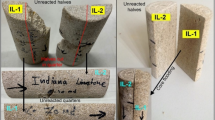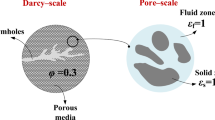Abstract
Limestone dissolution by \(\hbox {CO}_2\)-rich brine induces critical changes of the pore network geometrical parameters such as the pore size distribution, the connectivity, and the tortuosity which govern the macroscopic transport properties (permeability and dispersivity) that are required to parameterize the models, simulating the injection and the fate of \(\hbox {CO}_2\). A set of four reactive core-flood experiments reproducing underground conditions (\(T = 100\,^{\circ }\hbox {C}\) and \(P = 12\) MPa) has been conducted for different \(\hbox {CO}_2\) partial pressures \((0.034 < P_{\mathrm{CO}_2}< 3.4\; \hbox {MPa})\) in order to study the different dissolution regimes. X-ray microtomographic images have been used to characterize the changes in the structural properties from pore scale to Darcy scale, while time-resolved pressure loss and chemical fluxes enabled the determination of the sample-scale change in porosity and permeability. The results show the growth of localized dissolution features associated with high permeability increase for the highest \(P_{\mathrm{CO}_2}\), whereas dissolution tends to be more homogeneously distributed for lower values of \(P_{\mathrm{CO}_2}\). For the latter, the higher the \(P_{\mathrm{CO}_2}\), the more the dissolution patterns display ramified structures and permeability increase. For the lowest value of \(P_{\mathrm{CO}_2}\), the preferential dissolution of the calcite cement associated with the low dissolution kinetics triggers the transport that may locally accumulate and form a microporous material that alters permeability and produces an anti-correlated porosity–permeability relationship. The combined analysis of the pore network geometry and the macroscopic measurements shows that \(P_{\mathrm{CO}_2}\) regulates the tortuosity change during dissolution. Conversely, the increase of the exponent value of the observed power law permeability–porosity trend while \(P_{\mathrm{CO}_2}\) increases, which appears to be strongly linked to the increase of the effective hydraulic diameter, depends on the initial rock structure.














Similar content being viewed by others
References
Archie, G.E.: Classification of carbonate reservoir rocks and petrophysical considerations. AAPG Bull. 36, 278–298 (1952)
Bachu, S., Adams, J.: Sequestration of CO\(_2\) in geological media in response to climate change: capacity of deep saline aaquifers to sequester CO\(_2\) solution. Energy Convers. Manag. 44, 3157–3175 (2003)
Battiato, I., Tartakovsky, D.: Applicability regimes for macroscopic models of reactive transport in porous media. J. Contami. Hydrol. 120–121, 18–26 (2011). doi:10.1016/j.jconhyd.2010.05.005
Bear, J.: Dynamics of Fluid in Porous Media. Dover, New York (1988)
Ben Clennell, M.: Tortuosity: a guide through the maze. Dev. Petrophys. Geol. Soc. Lond. Special Publ. 122, 299–344 (1997)
Bernabe, Y., Brace, W., Evans, B.: Permeability, porosity and pore geometry of hot-pressed calcite. Mech. Mater. 1, 173–183 (1982). doi:10.1016/0167-6636(82)90010-2
Blum, H.: A transformation for extracting New descriptors of shape. In: Wathen-Dunn, W. (ed.) Models for the Perception of Speech and Visual Form, pp. 362–380. MIT Press, Cambridge (1967). http://citeseer.nj.nec.com/context/77000/0
Carman, P.: Fluid flow through granular beds. Trans. Inst. Chem. Eng. 15, 150 (1937)
Daccord, G., Lenormand, R., Litard, O.: Chemical dissolution of a porous medium by a reactive fluid-I. Model for the “wormholing” phenomenon. Chem. Eng. Sci. 48(1), 169–178 (1993)
de Marsily, G.: Hydrogeologie Quantitative. Masson, Rio de Janeiro (1981)
Dentz, M., Gouze, P., Russian, A., Dweik, J., Delay, F.: Diffusion and trapping in heterogeneous media: an inhomogeneous continuous time random walk approach. Adv. Water Resour. 49, 13–20 (2012)
Dullien, F.: Porous Media: Fluid Transport and Pore Structure. Academic Press, San Diego (1992)
Epstein, N.: On tortuosity and the tortuosity factor in flow and diffusion through porous media. Chem. Eng. Sci. 44, 777–779 (1989)
Flannery, B.P., Deckman, H.W., Roberge, W.G., Dámico, K.L.: Three-dimensional X-ray microtomography. Science 237, 1439–1444 (1987)
Focke, J., Munn, D.: Cementation exponents in Middle Eastern carbonate reservoir. Soc. Petrol. Eng. Form. Evaluation 2, 155–167 (1987)
Fredd, C.N., Fogler, H.S.: Influence of transport and reaction on wormhole formation in porous media. AIChE J. 44(9), 1933–1949 (1998)
Glassley, W.E., Simmons, A.M., Kercher, J.R.: Mineralogical heterogeneity in fractured, porous media and its representation in reactive transport models. Appl. Geochem. 17(6), 699–708 (2002)
Golfier, F., Zarcone, C., Bazin, B., Lenormand, R., Lasseux, D., Quintard, M.: On the ability of a Darcy-scale model to capture wormhole formation during the dissolution of a porous medium. J. Fluid Mech. 457, 213–254 (2002)
Gouze, P., Luquot, L.: X-ray microtomography characterization of porosity, permeability and reactive surface changes during dissolution. J. Contam. Hydrol. 120–121(C), 44–55 (2011)
Hoefner, M.L., Fogler, H.S.: Pore evolution and channel formation during flow and reaction in porous media. AIChE J. 34(1), 45–54 (1988)
Holloway, S.: An overview of the undergunder disposal of carbon dioxide. Energy Convers. Manag. 38, 193–198 (1997)
Hoshen, J., Kopelman, R.: Percolation and cluster distribution. I. Cluster multiple labeling technique and critical concentration algorithm. Phys. Rev. B 14(8), 3438–3445 (1976). doi:10.1103/PhysRevB.14.3438
ISRM: Suggested methods for determing water content, porosity, density, absorption and related properties and swelling and slake durability index properties, in rock characterization, testing and monitoring. Tech. rep., International Society for Rock Mechanics (1979)
Jamtveit, B., Yardley, B.: Fluid Flow and Transport in Rocks: Mechanisms and Effects. Chapman and Hall, London (1997)
Kozeny, J.: Über die kapillare leitung des wassers im boden. Sitz. Ber. Akad. Wiss. Wien, Math. Nat. 136, 271–306 (1927)
Lasaga, A.: Kinetic Theory in the Earth Sciences. Princeton Series in Geochemistry. Princeton University Press, Princeton (1998)
Lee, T.C., Kashyap, R.L., Chu, C.N.: Building skeleton models via 3-D medial surface axis thinning algorithms. CVGIP: Graph. Models Image Process. 56(6), 462–478 (1994). doi:10.1006/cgip.1994.1042
Lichtner, P., Steefel, C., Oelkers, E.H.: Reactive Transport in Porous Media. Mineralogical Society of America, Washington, DC (1997)
Lindquist, W.B., Venkatarangan, A.: Investigating 3D geometry of porous media from high resolution images. Phys. Chem. Earth Part A 24(7), 593–599 (1999). doi:10.1016/S1464-1895(99)00085-X
Luquot, L., Gouze, P.: Experimental determination of porosity and permeability changes induced by injection of CO\(_2\) into carbonate rocks. Chem. Geol. 265(1–2), 148–159 (2009)
Luquot, L., Andreani, M., Gouze, P., Camps, P.: CO\(_2\) percolation experiment through chlorite/zeolite-rich sandstone (Pretty Hill Formation—Otway Basin-Australia). Chem. Geol. 294–295, 75–88 (2012). (Cited By (since 1996):3)
Madonna, C., Almqvist, B.S., Saenger, E.H.: Digital rock physics: numerical prediction of pressure-dependent ultrasonic velocities using micro-CT imaging. Geophys. J. Int. 189(3), 1475–1482 (2012). doi:10.1111/j.1365-246X.2012.05437.x. http://gji.oxfordjournals.org/content/189/3/1475.abstract, Accessed 31 Oct 2013
Mangane, P.O., Gouze, L., Gouze, P., Luquot, L.: Permeability impairment of a limestone reservoir triggered by heterogeneous dissolution and particle migration during CO\(_2\)-rich injection. Geophys. Res. Lett. 40(17), 4614–4619 (2013) doi:10.1002/grl.50595.
Mavko, G., Nur, A.: The effect of a percolation threshold in the Kozeny–Carman relation. Geophysics 62, 1480–1482 (1997)
Meijster, A., Roerdink, J.B., Hesselink, W.H.: A general algorithm for computing distance transforms in linear time. Math. Morphol. Appl. Image Signal Process 18, 331–340 (2002)
Meile, C., Tuncay, K.: Scale dependence of reaction rates in porous media. Adv. Water Resour. 29(1), 62–71 (2006)
Molins, S., Trebotich, D., Steefel, C.I., Shen, C.: An investigation of the effect of pore scale flow on average geochemical reaction rates using direct numerical simulation. Water Resour. Res. 48(3) (2012). doi:10.1029/2011WR011404
Montenato, C., Guery, F.,Berthou, P.: In: Proceeding of the Ocean Drilling Program 103 (1988)
Mougenot, D., Monteiro, J., Dupeuble, P., Malod, J.: La marge continentale sud -portugaise: évolution structurale et sédimentaire. Ciencias da Terra 5, 223–246 (1979)
Noiriel, C., Gouze, P., Bernard, D.: Investigation of porosity and permeability effects from microstructure changes during limestone dissolution. Geophysical. Res. Lett. 31(24), 1–4 (2004)
Noiriel, C., Luquot, L., Mad, B., Raimbault, L., Gouze, P., van der Lee, J.: Changes in reactive surface area during limestone dissolution: an experimental and modelling study. Chem. Geol. 265(1—-2), 160–170 (2009)
Palain, C.: Une srie dtritique terrigne. les grs de silves: Trias et lias infrieur du portugal. Tech. rep., Servicio Geologico Portugal (1979)
Pape, H., Clauser, C., Iffland, J.: Permeability prediction based on fractal pore-space geometry. Geophysics 64(5), 1447–1460 (1999)
Parkhurst, D.L., Appelo, C.A.J.: User guide to phreeqc (version2). A computer program for speciation, batch-reaction, one-dimensional, transport. 99–4259 (1999)
Qajar, J., Francois, N., Arns, C.H.: Micro-tomographic characterization of dissolution-induced local porosity changes including fines migration in carbonate rock. Soc. Petrol. Eng. 1, 117–134 (2012)
Rege, S.D., Fogler, H.S.: Network model for straining dominated particle entrapment in porous media. Chem. Eng. Sci. 42(7), 1553–1564 (1987)
Renard, F., Gratier, J.P., Ortoleva, P., Brosse, E., Bazin, B.: Self-organization during reactive fluid flow in a porous medium. Geophys. Res. Lett. 25(3), 385–388 (1998)
Robinson, R., Stokes, R.H.: Elctrolyte solutions: The Measurement and Interpretation of Condutance, Chemical Potential and Diffusion in Solutions of Simple Electrolytes. Butterworths, London (1959)
Schechter, R., Gidley, J.: The change in pore size distribution from surface reaction in porous media. AIChE J. 15, 339–350 (1969)
Siddiqi, K., Pizer, S.: Medial Representations: Mathematics, Algorithms and Applications, 1st edn. Springer, Berlin (2008)
Spirkovska, L.: A summary of image segmentation techniques: Nasa technical memorandum. Tech. rep., NASA, California USA (1993). http://ntrs.nasa.gov/archive/nasa/casi.ntrs.nasa.gov/19940006802_1994006802.pdf, Accessed 17 July 2013
Steefel, C., Lasaga, A.: Evolution of dissolution patterns: permeability change due to coupled flow and reaction. In: Melchior, D., Bassett, R.L. (eds.) Chemical Modeling of Aqueous Systems II. American Chemical Society, Washington, DC (1990)
Torquato, S.: Random Heterogeneous Materials: Microstructure and Macroscopic Properties. Springer, Berlin (2002)
Verwer, K., Eberli, G., Weger, R.: Effects of pore structure on electrical resistivity in carbonates. AAPG Bull. 95–2, 175–190 (2011)
Acknowledgments
This work was supported by TOTAL S.A. and by the PANACEA project (European Community FP7/2007-2013, ENERGY.2011.5.2-1 under grant agreement no. 282900). We would like to thank Dimitri Laurent for contribution in the course of his Master Degree and Paul Tafforeau and Elodie Boller from ESRF for their precious help during the XMT acquisition.
Author information
Authors and Affiliations
Corresponding author
Electronic supplementary material
Below is the link to the electronic supplementary material.
Rights and permissions
About this article
Cite this article
Luquot, L., Rodriguez, O. & Gouze, P. Experimental Characterization of Porosity Structure and Transport Property Changes in Limestone Undergoing Different Dissolution Regimes. Transp Porous Med 101, 507–532 (2014). https://doi.org/10.1007/s11242-013-0257-4
Received:
Accepted:
Published:
Issue Date:
DOI: https://doi.org/10.1007/s11242-013-0257-4




